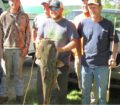By Clark Schmitz
When early settlers came to Iowa they found numerous game animals which included the white- tail deer. The deer provided a food source, and hides for clothing. The unregulated hunting in the late 1800’s caused the deer numbers to be reduced to the point that deer hunting was banned in 1898.
Deer were reintroduced in Iowa by transporting small groups from other states. These small groups of deer slowly but steadily grew in numbers and in December of 1953 the first regulated deer season was opened with 4000 animals harvested.
Deer numbers in Iowa continued to climb due to sound game management by the Iowa DNR and regulated hunting. By 2005-2006 the deer numbers had gotten so large that more liberal seasons were adopted to find a balance with farm crop damage, deer-car collisions and hunting. The increased harvest of does was successful in reducing deer numbers while providing additional deer hunting opportunities for hunters.
In 2012 Iowa (and a good portion of the country) experienced a severe drought which resulted in the first large scale experience with EHD (Epizootic Hemorrhagic Disease) infested deer in Iowa. In NW Iowa the death loss from EHD was estimated by land owners and hunters in the 30% to 50% range. Since 2012 there have been isolated reports of more EHD deaths but nothing as dramatic as 2012.
More recently concerns have shifted somewhat to CWD (Chronic Wasting Disease) which seems to be slowly moving into areas that historically had been void of the disease.
The Iowa DNR actively monitors diseases affecting deer in the state. The primary diseases that are monitored include Chronic Wasting Disease (CWD), Hemorrhagic Disease/Blue Tongue (HD), and Bovine Tuberculosis (TB).
Epizootic Hemorrhagic Disease and blue tongue (HD) are diseases that are spread by a biting midge that causes high fever in infected deer and also causes the cell wall in heart, lungs, and diaphragm tissue to weaken and burst. HD cannot be transferred from deer to deer. Most deer die in one to four days after being infected with HD. Deer can build up an immunity to persistent strains of HD, as they have in many southern states. Drought years augment the disease as deer are more concentrated around water sources. It is important to know that HD effects are temporary, and on broad scale population-level effects in Iowa have historically occurred infrequently.
Bovine Tuberculosis (TB) is a bacterial disease that affects the respiratory system, and is primarily transferred through respiratory secretions between individual animals. Currently there is no evidence of TB in Iowa’s deer herd. TB remains an important disease to monitor because it can be transferred from livestock to deer and vice-versa.
Chronic Wasting Disease (CWD) is a neurological disease affecting primarily deer and elk. An abnormal protein, called prion, attacks the brain causing weight loss, abnormal behavior and loss of bodily functions. Signs of CWD in deer include excessive salivation, thirst and urination, loss of appetite, weight loss, listlessness and drooping ears and head. CWD is always fatal to the infected animal. Testing for the CWD protein is not a food safety test. Currently it is not believed that humans can contract CWD by eating venison; however, the center for Disease Control and Prevention recommends, when hunting in areas with CWD, strongly consider having the deer tested for CWD before you eat the meat. If your animal tests positive for CWD do not eat the meat.
Under Iowa law, hunters cannot transport into the state the whole carcass of any cervid (i.e., deer, elk, moose) taken from a CWD-infected area. Only the boned-out meat, the cape, and antlers attached to a clean skull plate (from which all brain tissue has been removed) are legal to transport into Iowa.
Chronic Wasting Disease was first found in Colorado in 1967 in a mule deer at a research facility. Since then confirmed cases have been found in twenty-four states and three Canadian provinces. The first confirmed case in Iowa was found in Allamakee County in 2013. Testing for CWD started in Iowa in 2002 and 51,000. negative tests were done prior to the first confirmed case in 2013. It is believed that the infected deer either came from Wisconsin where confirmed CWD deer were tested or from a deer game farm. 18 cases of CWD have been confirmed in wild deer in Iowa thru 2016. All are in the East and North East part of the state.
CWD is particularly concerning as the abnormal protein “prion” present in infected deer (and is responsible for transmitting the disease) is difficult to harness. The prion is known to resist disinfectants, alcohol, formaldehyde, detergents, radiation, freezing, incineration and others.
Scientific research as a unified effort is needed to control CWD. Efforts being made to control the diseases include, containing its geographic spread, encourage convenient cost free rapid testing of all animals harvested in CWD affected areas, ensure that no CWD infected material reaches the deer’s food chain and instead is properly disposed of, and establish research and science based policy to protect wildlife and public interests.
The Iowa DNR is asking all hunters to help in the fight against CWD. A harvested infected deer can no longer make direct contact with other deer, helping slow the disease. Infected deer may not display symptoms and testing is the only way to know if the deer is infected. Here are three ways you can help fight CWD and ensure the health of Iowa’s deer herd for future generations. 1. Provide the sample. Call and a DNR biologist will come to you and collect a sample. 2. Stop the spread. Do not use feed or salt mineral licks to attract deer. These bait sights increase the concentration of deer which spreads the disease. And 3. Properly transport and dispose. Do not leave carcass or bones to decay on the land. Contact your local waste hauler for requirements. Do not dump carcasses outside of the area where the deer was shot, as this will spread the disease to new areas.
Fortunately the vast majority of our herds are disease free and with the help of our wildlife agencies, game biologists and concerned hunters and sportsman we can continue to enjoy our deer in Iowa for generations to come.













